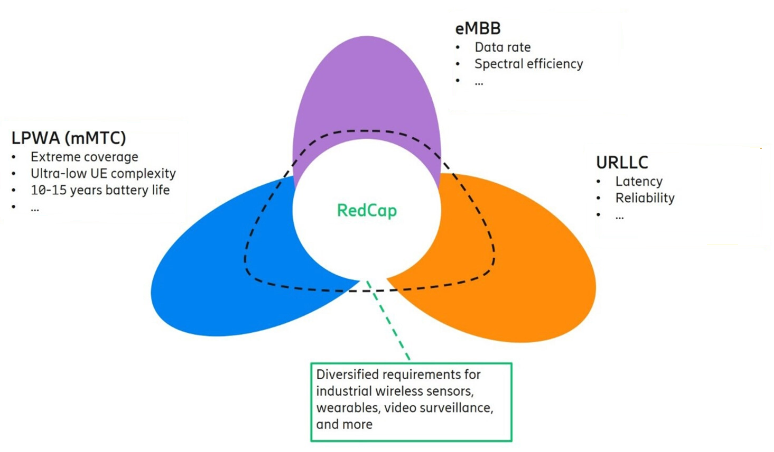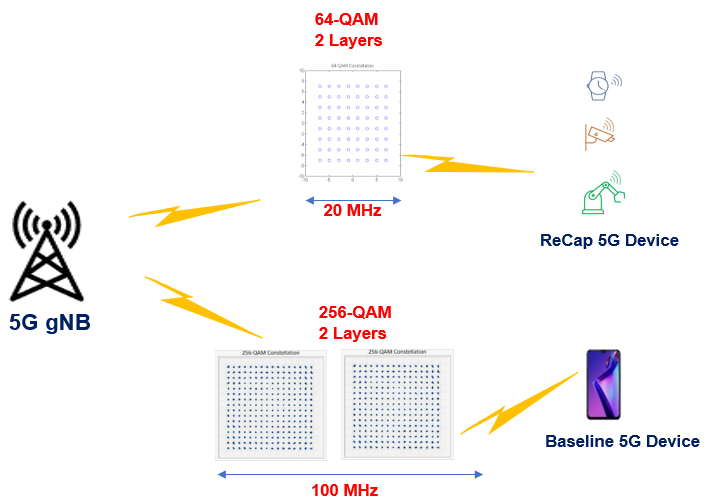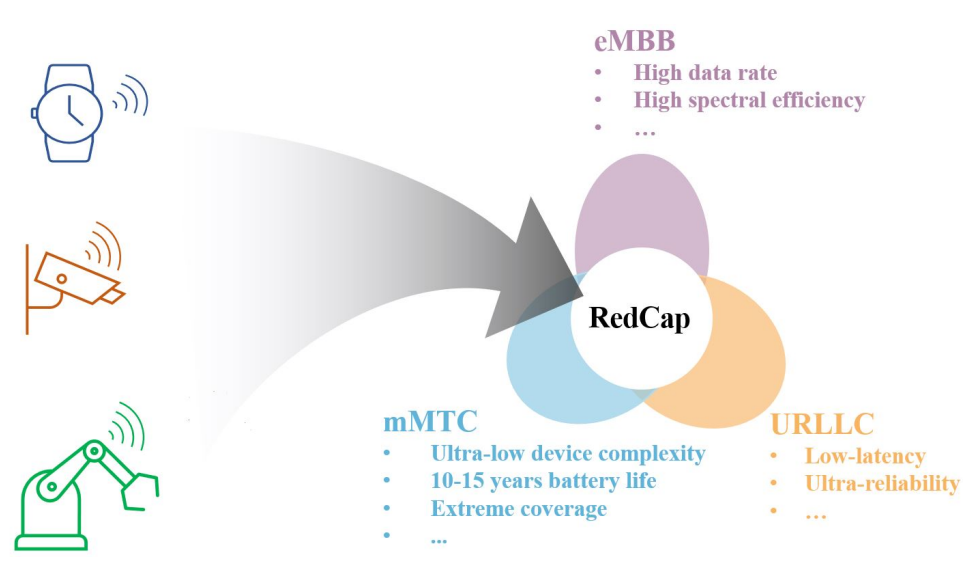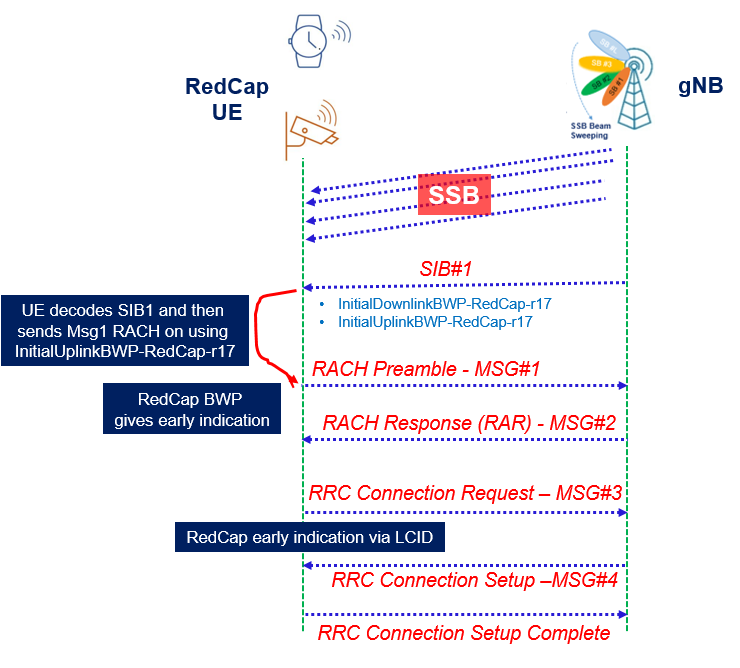What is 5G NR Light – Reduce Capability?
5G NR Light Introduction
In 5G NR Release 17, 3GPP has introduced a new tier of reduced capability (RedCap) devices, also known as NR-Light. It is a new device category that bridges the capability and complexity gap between Low-Power Wide-Area (LPWA) and URLCC uses in 5G today with an optimized design for mid-tier use cases.
RedCap devices aims for lower costs and complexity and smaller physical size and longer battery life as compared to conventional 5G NR devices. In this article, we present our study and short notes from different available resources.

NR-Light Key Pointers
- NR-light UE is also known as Reduced Capability (RedCap) UE
- 3GPP TS 38.875 specification provides all technical recommendations
- NR light supports both FR1 and FR2 frequency ranges with FDD and TDD duplexing
- NR light shall support Max Device bandwidth 20MHz with FR1 and 100MHz with FR2
- NR light shall support minimum 1 Rx antenna configuration with FR1 and 2 Rx antenna with FR2 at the device
- NR light shall support min. one DL MIMO layers
- NR light shall support max. DL modulation order as 64 QAM
- NR light shall support max. data radio bearers (DRBs) as 8
- NR light shall support PDCP SN length as 12 bits
- With NR light device support for ANR functionality is not mandatory
- Max. Coupling loss requirement is 140dB
- NR light shall Low transmit power, not mandatory to support 23dBm
Why NR-light or RedCap?
The 3GPP has introduced the concept of RedCap to build a UE that can be benefit from 5G NR deployments but leverage fewer 5G NR capabilities for an optimum balanced set of features versus cost and power consumption.

URLLC, mMTC, and Terrestrial Networks supports IoT connectivity with high-bandwidth and low-latency requirements, such as manufacturing line robotics and drones. But they do not necessarily cover connectivity for sensors, actuators, and other IoT equipment with lower performance requirements with cost-or form-factor constrains.
These devices may send asynchronous information in small packets but need radical cost optimization in initial purchase and operational maintenance for which battery life duration is critical.
3GPP release 17 specifications are being developed to support following three use Case with RedCap devices.
- Industry Wireless Sensor
- Video Surveillance Devices
- Wearables to relay health and wellness data.
RedCap Use cases and Requirements
As discussed in above paragraph, RedCap is being design to support major three use case : Industry Sensors, Surveillance, and Wearable. Each one of this have specific requirement in terms of Max Data rates, Latency and Service availability listed below.

- Industry Wireless Sensor
- Data rate (max) : 2 Mbps
- End-to-end latency: < 100 ms
- Service availability: 99.99%
- Device battery lifetime: At least few years
- Traffic pattern: Uplink Heavy
- Mobility: No
- Video Surveillance
- Data rate (max) : 150 Mbps (DL), 50 Mbps (UL)
- End-to-end latency: < 500 ms
- Service availability: 99%
- Device battery lifetime: NA
- Traffic pattern: Uplink Heavy
- Mobility: No
- Wearables
- Data rate (max) : 25 Mbps
- End-to-end latency: NA
- Service availability: NA
- Device battery lifetime: few days and up to 1-2 weeks
- Traffic pattern: Uplink Heavy
- Mobility: Yes
Comparison between 5G Baseline and RedCap Devices
Following table shows high level difference between 5G Baseline device and RedCap Device for FR1 and FR2 frequency range.

Key RRC parameters relevant to RedCap device
For the 5G gNB, the primary impact from the introduction of RedCap devices is the need to adapt to their specific features during the initial Cell camping and RACH process and when the device stays connected. New information elements (IEs) handle those processes,
- cellBarredRedCap-r17: This parameter is sent within SIB#1 by the gNB. If SIB#1 indicates the cell “Barred” the RedCap UE cannot camp to it and needs to start the RRC procedure to find another cell which is “NotBarred”
- intraFreqReselectionRedCap-r17: This parameter is necessary for RedCap UE support; if not present, the cell will be barred
- halfDuplexRedCapAllowed: If not present, then the UE shall consider the cell barred and consider re-selection to other cells on the same frequency
- initialDownlinkBWP-RedCap: It indicates the initial DL BWP the UE will use during RACH procedure
- initialUplinkBWP-RedCap: It indicates the initial UL BWP the UE will use during RACH procedure
- intra-SlotFH-r17: A RedCap UE will apply different intra-slot PUCCH frequency hopping when this parameter is enabled
- redCapAccessAllowed-r17: Indicates if RedCap UE may access the frequency, prevents RedCap UEs from measuring neighbor cells not supporting RedCap. It is transmitted as part of SIB#4 from gNB
- relaxedMeasurement-r17: It adds “stationary” and “cell edge while stationary” concepts; when present, the RedCap device can apply some relaxations described in 3GPP 38.133
- Logical Channel Identifier (LCID): Specific values for RedCap devices are defined and used to identify the device as “RedCap” during Msg3
RedCap UE Call Flow
Following figure shows the basic call flow for 5G RedCap device. It does follow the same procedure as of baseline UE does for initial SSB synchronization.

- After Decoding the Physical Cell ID and Master Information Block (MIB) from the SSB, UE tries to decode SIB#1.
- SIB#1 broadcast information gives an early indication support of RedCap a the gNodeB.
- Using SIB#1 parameter cellBarredRedCap-r17 RedCap UE decides to camp in a cell or not.
- After Cell camping decision, UE decodes the DL and UL bandwidth part required during the RACH procedure.
- UE use InitialUplinkBWP-RedCap-r17 for MSG#1, although gNB can allow the UE to use a specific initial BWP for RedCap devices or reduce the BWP size requirement to enable the RedCap UE to complete the Registration process
- The gNB can also identify the UE is a RedCap UE by using Msg3 logical channel identifier (LCID)
References
- 3GPP TS 38 133 5G NR, Requirements for support of radio resource management
- 3GPP TR 38.875- Study on support of reduced capability NR devices
- What is reduced capability (RedCap) NR and what will it achieve?
- 5G/NR – NR Light/RedCap
Related Posts
- 5G Standalone Mode Registration-Attach Call Flow
- 5G RAN and 5GC Network Slice Signaling
- 5G SA Handover – Inter gNB-DU and Intra gNB-CU Handover
- 5G SA Xn Handover Call flow
- 5G SA N2-NGAP Handover Call flow
Author

